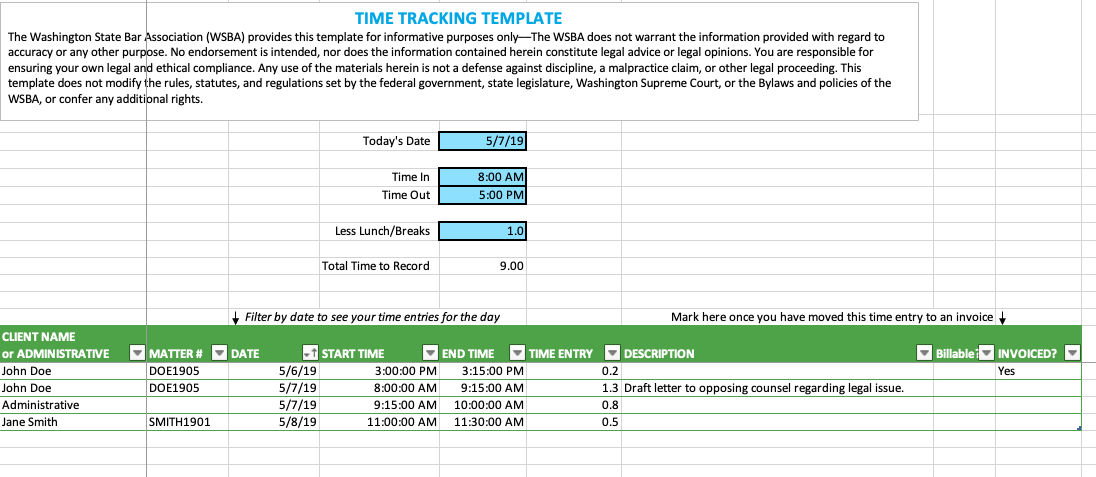Attorney time and billing software helps law firms better manage their billing process by assisting with time tracking, invoice generation, expense monitoring, collections, and more. Timekeeping software for lawyers offers features that typical accounting software does not — features essential for compliance in the practice of law, such as monitoring billable hours and accommodating trust accounting.
Legal time and billing software brings a new level of efficiency, accuracy, and security to the billing process for attorneys. Keep reading to learn the basics of time and billing software for law firms and what benefits this software can provide your practice.

How Do Attorneys Keep Track of Their Time Using Software?
Attorney time and billing software has several features for legal time tracking — namely, digital timers that can be categorized by client, matter, and activity. This allows legal professionals to log time as they work on various tasks throughout the day, easily stopping and starting different timers as they switch tasks. When it’s finally time to prepare an invoice, the timers provide a clear record of what was done.
Rather than needing to remember each task and guess how long it took to perform, time tracking software makes it easy to record the time you spend on each task, even sorting it according to different hourly rates in your firm. Additionally, quality time tracking software often comes with a mobile app version, which lets you track time whether you’re in the office or leaving a court appearance. Switching between matters is as simple as stopping one timer and starting another.
How Does Legal Billing Work Through Software?
Once you’ve completed time entries for your billable tasks, legal billing software helps you quickly convert those entries to invoices. The most helpful features for this process include:
- Flexible rate structures to accommodate hourly rates, flat fees, or any other alternative fee arrangements.
- Customizable formatting to better match your firm’s brand or format aesthetics.
- Batch invoicing to simplify billing for ongoing services or high volumes of transactions.
From there, billing software can also assist with sending out invoices, collecting payment, and even issuing client reminders on automatic schedules. By removing much of the repetitive, time-consuming parts of the billing process, you have more time and mental energy to devote to your clients as well as billable tasks.
Software also speeds up the prebill review process with automation that catches errors and cuts down review time. Plus, it helps firms collect payments faster by giving clients a secure portal with 24/7 access to view and pay invoices online.

What Really Sets Good Time and Billing Software Apart for Attorneys?
The most important traits for time tracking software are convenience, reliability, and user-friendliness. The complex nature of legal billing makes it critical that any support software is simple to navigate, so you can find the information you need when you need it.
Some of the best features of a great billing software include:
- Automatic Payment Reminders | Rather than chasing down every unpaid invoice and having to track what’s been paid, schedule reminders to each client for collections
- Client Portals | Quickly see each client’s key information, including open matters, client budget, and billing rates that are specific to them
- Cloud-Based Software | Using a cloud-based program means less upfront cost, less infrastructure, and far more flexibility — including smartphone-compatible solutions to use on the go
- Reporting and Analytics | Get a better sense of your firm’s expenses, overhead, and which matters bring in the most success for your business
- Trust Accounting Management | Legal billing software works for lawyers in unique ways, including features that accommodate specific needs, such as IOLTA accounts
Legal billing software simplifies the way you track time, generate invoices, and collect payments. It also eliminates the work of transferring time logs to invoices by consolidating both processes to the same place. But also, and perhaps more importantly, it’s designed to fit the way you work.
Good billing software won’t add steps to your day or create more headaches, but quite the opposite: it will remove friction from your billing process, eliminate repetitive tasks, and leave a lot less room for error. Most software is also now cloud-based, meaning that if you have an internet-enabled device of any kind — be it phone, desktop, or laptop — you can start using this software as soon as today.
Bill4Time: The Best Timekeeping and Billing Software for Attorneys
Lawyers need their software to be intuitive, easy to navigate, and compliant with legal ethics. At Bill4Time, we place a strong focus on making solutions that make your job as a legal professional easier: by simplifying, streamlining, and securing the billing process.
Bill4Time lets you spend less time managing, and more time practicing — by automating the most time intensive billing processes and ensuring you always have access to client information, both in and out of the office.
Ready to make your billing process a whole lot easier? See for yourself what Bill4Time can do, and sign up for a free trial today. You can also click the button below to schedule a free custom demo, and we’ll walk you through how Bill4Time would work for your firm.




